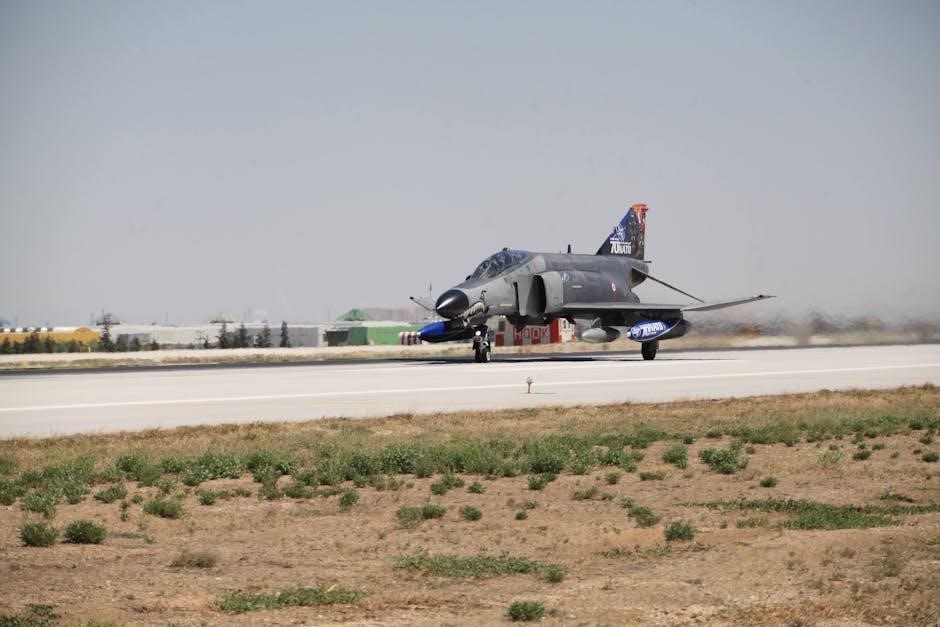The 4-2-5 defense playbook is a versatile scheme emphasizing speed and agility, ideal for modern football. It features 4 linemen, 2 linebackers, and 5 defensive backs, blending flexibility with strategic pressure. This playbook is widely used in college and NFL teams due to its adaptability against various offenses. Coaches appreciate its ability to create negative plays and disguise coverages, making it a cornerstone of defensive strategies. With proper installation, it can elevate any team’s defensive performance.
Overview of the 4-2-5 Defense
The 4-2-5 defense is a dynamic scheme featuring four defensive linemen, two linebackers, and five defensive backs. This structure allows for flexibility in both pass and run defense. The four down linemen provide a strong pass rush, while the five defensive backs offer versatility in coverage. The two linebackers act as the backbone, supporting both the line and the secondary. This alignment is particularly effective in modern football, where offenses often employ multiple receivers and spread formations. Its adaptability makes it a popular choice for coaches seeking balance and aggression.
Importance of the Playbook in Modern Defense Strategies
The 4-2-5 defense playbook is integral to modern strategies due to its versatility and adaptability. It effectively counters spread offenses by utilizing five defensive backs for enhanced pass coverage. The scheme allows for aggressive blitz packages and disguised coverages, making it difficult for offenses to anticipate defensive alignments. Its flexibility enables coaches to tailor strategies to specific opponents, ensuring a balanced approach to both run and pass defense. This playbook is a cornerstone for teams seeking to disrupt modern offensive schemes while maintaining defensive integrity.

Position Breakdown in the 4-2-5 Defense
The 4-2-5 defense features four defensive linemen, two inside linebackers, and five defensive backs, including two cornerbacks, one free safety, and two hybrid linebacker/safety players known as “Dogs.”
Defensive Linemen: Roles and Responsibilities
The defensive linemen in the 4-2-5 scheme are crucial for stopping the run and pressuring the quarterback. Their primary roles include occupying blockers, maintaining gap integrity, and rushing the passer. They must be physical at the point of attack, using techniques like hand fighting and leverage to control the line of scrimmage. Additionally, they may drop into coverage in specific zone blitz packages, adding versatility to the defense. Their ability to free up linebackers and defensive backs is essential for the scheme’s success. Effective linemen balance strength and agility, ensuring consistent disruption against both run and pass plays.

Linebackers: Key Positions and Duties
In the 4-2-5 defense, the two linebackers are the backbone of the unit, responsible for stopping the run, covering underneath routes, and blitzing. The Mike linebacker serves as the defensive quarterback, calling adjustments and aligning the front. The Will linebacker focuses on flow-to-the-ball mentality, attacking gaps and covering tight ends. Both must read offensive keys quickly, fill holes decisively, and drop into zone coverage when required. Their ability to blitz effectively adds pressure on third downs, making them versatile playmakers in the scheme.
Defensive Backs: Responsibilities and Alignments
The 4-2-5 defense features five defensive backs, including two cornerbacks, one free safety, and two hybrid outside linebackers/safeties (Dogs). Cornerbacks primarily cover receivers in man-to-man or zone schemes, while the free safety provides deep support. The hybrid safeties often blitz or cover tight ends; Alignments vary based on offensive formations, with defensive backs adjusting to create mismatches. Their versatility allows for effective pass coverage and run support, making them crucial in both base and blitz packages.

Defensive Philosophy and Concepts
The 4-2-5 defense emphasizes creating negative plays through pressure and disguise, focusing on disrupting the offense’s rhythm. It combines speed and agility to outmatch opponents, ensuring flexibility and strategic dominance.
Creating Negative Plays and Disguising Coverage
Creating negative plays is a cornerstone of the 4-2-5 defense, achieved through aggressive blitz schemes and strategic alignment. By disguising coverages, defenders confuse the offense, limiting their ability to anticipate plays. This approach forces offenses into unfavorable down-and-distance situations, increasing the likelihood of turnovers and stalled drives. Effective disguise and timely pressure are key to disrupting rhythm and control the game’s flow, making the 4-2-5 a dynamic and unpredictable defensive system.
Blitz Packages and Pressure Schemes
The 4-2-5 defense excels at applying pressure through diverse blitz packages; By utilizing linebackers and defensive backs, it creates confusion for the offense. Specific blitzes target the quarterback, forcing quick decisions and potential turnovers. The “Sam,” “Mike,” and “Will” positions are often key blitzers, while defensive backs provide additional pressure. These schemes are designed to disrupt rhythm and create negative plays, making the 4-2-5 a formidable system for controlling the game’s tempo and opposing offenses.

Installation and Setup of the 4-2-5 Defense
Installing the 4-2-5 defense begins with teaching fundamentals and base alignments. Players must understand their roles and how to adapt to different offensive formations. Initial setup focuses on positioning linemen, linebackers, and defensive backs to maximize versatility. Coaches emphasize communication and pre-snap adjustments to ensure the defense is prepared for any offensive strategy, making it a dynamic and effective system.
Base Alignments and Initial Setup
The 4-2-5 defense begins with base alignments that position four down linemen, two inside linebackers, and five defensive backs. The linemen are spaced evenly to control gaps, while linebackers align behind them to fill holes. Cornerbacks play press coverage, the free safety provides deep support, and hybrid “Dogs” cover flats or blitz. Initial setup emphasizes communication and pre-snap adjustments, ensuring flexibility against various offenses. This alignment balances coverage and pressure, allowing the defense to adapt while maintaining aggression and discipline.
Adjustments and Tweaks for Different Offenses
The 4-2-5 defense adapts to offenses by adjusting personnel and alignments. Against run-heavy teams, defensive linemen shift to reinforce gaps, while linebackers cheat closer to the line. For pass-centric offenses, extra defensive backs are subbed in to enhance coverage depth. Blitz packages and coverage shells are tweaked to exploit weaknesses, with hybrids often blitzing or dropping into zones. These adjustments maintain defensive balance while countering specific offensive threats, ensuring versatility and effectiveness in various game scenarios;

Coverage Schemes in the 4-2-5 Defense
The 4-2-5 defense employs a mix of man-to-man and zone coverage, utilizing hybrid players to disguise schemes. This versatility confuses offenses and creates advantageous matchups.
Man-to-Man and Zone Coverage Techniques

The 4-2-5 defense integrates man-to-man and zone coverage seamlessly, leveraging hybrid players like nickelbacks to match receivers. Press techniques at the line disrupt timing, while zone schemes provide deep support. Defensive backs employ “bail” and “trail” techniques to transition between coverages. linebackers often drop into underneath zones, creating confusion for quarterbacks. This blend of techniques allows the defense to adapt to various offenses while maintaining aggressive pressure and disguising coverages effectively. Flexibility is key in this scheme, ensuring consistent defensive success.

Advanced Coverage Strategies
Advanced coverage strategies in the 4-2-5 defense emphasize disguised looks and dynamic adjustments. Hybrid players, like the “Dogs,” often blur the lines between linebackers and safeties, creating mismatches. Pattern-matching concepts allow defenders to anticipate routes, while rotational safeties provide deep support. Blitz packages are timed to pressure quarterbacks into quick decisions. These strategies leverage the scheme’s flexibility, enabling defenders to adapt to offensive tendencies while maintaining aggressive play. Disguising coverages pre-snap keeps offenses guessing, enhancing the defense’s effectiveness in critical situations.

Strengths and Weaknesses of the 4-2-5 Defense
The 4-2-5 defense excels in versatility and speed, with hybrid players creating mismatches. Its weakness lies in vulnerability against power runs and vertical attacks if execution falters.
Flexibility and Versatility in Defensive Alignments
The 4-2-5 defense offers unmatched flexibility through hybrid positions. Defensive backs can act as linebackers, creating mismatches. This adaptability allows coaches to adjust alignments based on offensive formations, ensuring effective coverage and pressure. By utilizing versatile players, the defense can seamlessly transition between man-to-man and zone schemes. This flexibility is key in countering modern, dynamic offenses that emphasize speed and misdirection. Proper execution unlocks the defense’s full potential, making it a valuable asset for any team.
Potential Vulnerabilities and How to Address Them
The 4-2-5 defense can struggle against power running games due to fewer linebackers. To address this, coaches often adjust alignments or add extra defenders in the box. Additionally, overloading blitzes can leave the secondary vulnerable to deep passes. To mitigate this, emphasizing disciplined rush lanes and ensuring secondary help is critical. Hybrid players who excel in both run support and coverage are invaluable. With proper adjustments, the 4-2-5 can counter its weaknesses while maintaining its strategic advantages.

Case Studies and Examples
College teams like Oklahoma and NFL defenses have successfully implemented the 4-2-5 playbook, showcasing its adaptability in real-game scenarios and strategic effectiveness under various coaching philosophies.
Successful Implementation in College and NFL Teams
Prominent college programs, such as Oklahoma under Brent Venables, have thrived using the 4-2-5 defense, leveraging its versatility to counter modern offenses. NFL teams like the New England Patriots have adapted this scheme, emphasizing speed and agility. Coaches like Nick Saban have incorporated 4-2-5 principles, utilizing edge rushers and hybrid defenders to create pressure. Vanderbilt’s success with this playbook highlights its effectiveness in both collegiate and professional leagues, showcasing its adaptability and strategic depth in real-game scenarios.
Real-Game Scenarios and Adjustments
The 4-2-5 defense shines in real-game scenarios, allowing coaches to adapt quickly. For instance, Vanderbilt’s Clark Lea successfully adjusted by utilizing hybrid defenders to counter dynamic offenses. Coaches like Cameron Soran emphasize disguising coverages and blitz packages, creating confusion for quarterbacks. In-game adjustments, such as shifting to two-deep zones or activating “Dogs” for pressure, are critical. These strategies highlight the playbook’s flexibility and its ability to respond effectively to varying offensive tactics during live competition.
The 4-2-5 defense playbook offers flexibility and adaptability, making it a valuable asset for modern teams. Its ability to create negative plays and disguise coverages ensures long-term success, evolving with football’s dynamic landscape.
Final Thoughts on the 4-2-5 Defense Playbook
The 4-2-5 playbook is a dynamic, adaptable system that thrives in modern football. By combining speed, agility, and strategic pressure, it offers coaches a flexible framework to counter diverse offenses. Its emphasis on creating negative plays and disguising coverages makes it a reliable choice for teams seeking a balanced defense. With proper execution, this playbook can elevate defensive performance, ensuring sustained success in both college and professional leagues. Its evolution aligns with football’s changing landscape, making it a timeless defensive strategy.
Future Trends and Evolution of the 4-2-5 Defense
The 4-2-5 defense is expected to evolve with advancements in player athleticism and offensive schemes. Hybrid players, combining traits of linebackers and defensive backs, will become more prominent. Coaches will incorporate more dynamic blitz packages and adaptive coverages to counter modern spread offenses. Technology, such as AI-driven play calling, may enhance defensive strategies. The playbook will likely integrate more flexibility, allowing teams to seamlessly transition between base and nickel formations. This adaptability ensures the 4-2-5 remains a cornerstone of defensive football for years to come.